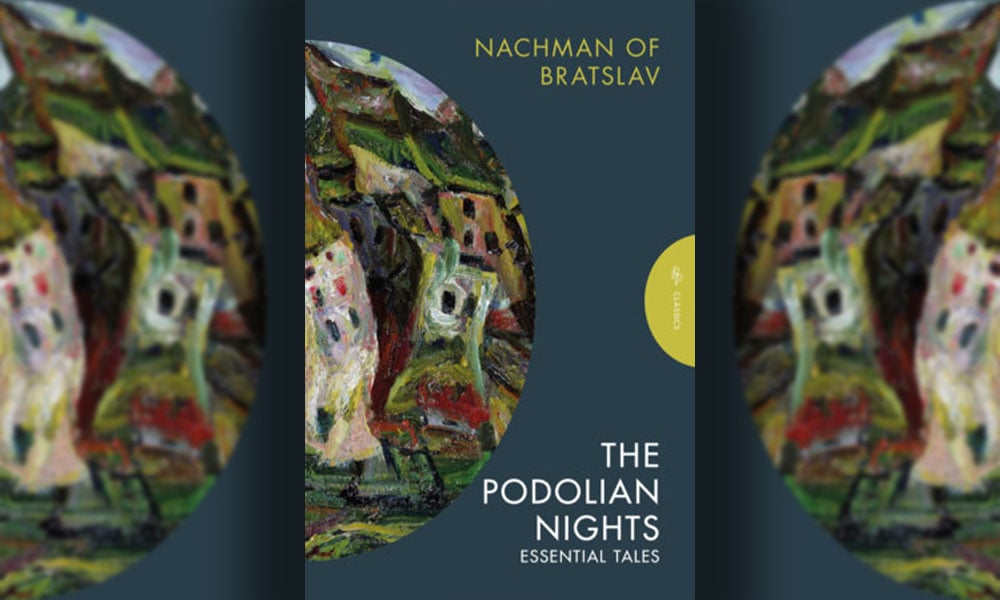
The Podolian Nights
By Nachman of Bratslav
Translated by Jordan Finkin and Robert Adler Peckerar
Introduction by Adam Kirsch
Pushkin Press, 233 pp.
It is highly unlikely that Nachman of Bratslav (1772-1810), the founder of the Bratslav Hasidic movement, chanced upon the works of Homer or Shakespeare before writing the 13 tales collected in The Podolian Nights. He lived most of his short life in the Hasidic enclaves of the Podolia region of what is now mainly western Ukraine, where there would have been little access to secular writings, especially those not yet existing in either Hebrew or Yiddish translation. In their translators’ note, Jordan Finkin and Robert Adler Peckerar consider the possibility that Nachman read one of the many Yiddish editions of One Thousand and One Nights then available in Podolia (hence the novel title of this volume), but there is little evidence to suggest that the pious rabbi had much appetite for nonreligious texts other than regional folk tales, from which he readily borrowed.
Nonetheless, “Of a King and an Emperor,” which tells of the adventures of an emperor’s daughter in her attempts to reunite with her beloved prince, recalls both the perils faced by Odysseus on his way back to Penelope and the comic escapades in Twelfth Night (including cross-dressing and ample drinking). “Of a Wise Man and a Simpleton,” a tale of a reversal of fortunes for the titular characters, could pass for an absurdist episode out of Russian novelist Nikolai Gogol’s Dead Souls, if not for the inconvenient detail that it was composed before Gogol was born.
Most often, however, those writers who occur as Nachman’s closest literary relations are from the 20th century, even though his tales feature kings and queens, demons and holy men, talking winds and the personified heart of the world (whose “little toenail…is heartier than any other heart”). Finkin and Peckerar in their note, along with Adam Kirsch in his superb introduction, point to the indecipherability of these tales as their most distinctly modern quality. Despite their rather basic narrative formula of a hero overcoming obstacles in pursuit of some righteous aim, none are easily decoded, even those that appear to be simple allegories. As Kirsch writes, “To read Nachman’s tales is to enter a world of elusive meanings, where the only thing certain is that the world as we know it is deeply broken.”
If Nachman is at all classifiable, he is an unwitting modernist, his enigmatic tales less historical relics than astonishingly prescient works.
Nachman’s protagonists are men and women determinedly seeking spiritual wholeness in this “deeply broken” world—where God, or any guiding moral force, appears absent. They seem to be the elder cousins of characters such as Bernard Malamud’s Arthur Fidelman, Cynthia Ozick’s Ruth Puttermesser, and Kafka’s Gregor Samsa and Josef K. (It is worth noting that Kafka is believed to have read Martin Buber’s retellings of Nachman’s tales, published in German in 1906.) If Nachman is at all classifiable, he is an unwitting modernist, his enigmatic tales less historical relics than astonishingly prescient works, as mesmerizing as they must have been over two centuries ago, when first told to his enraptured disciples. It is strange to think that today, outside the world of the Bratslav Hasidim—who still make annual pilgrimages to his grave—Nachman may be best known for a handful of sayings that would be at home on an apron hanging in a suburban kitchen, including “It is a great mitzvah to be happy always” and “Today you feel uplifted. Do not let yesterday and tomorrow bring you down.” Imagine if Hemingway’s legacy rested on the line “Every day is a new day.” Perhaps the strange and “deeply broken” world of his tales finds a faint echo in his best-known saying, often set to music: “The whole world is a narrow bridge, and the main thing is not to be afraid.”
That Nachman would become an important spiritual leader was virtually assured from the time of his birth. Kirsch notes that, as the great-grandson of Baal Shem Tov, the founder of Hasidism, Nachman “carried as heavy a burden of expectation as any prince.” Yet the would-be prince was tormented by religious doubt. Periods of ecstatic religiosity alternated with periods of intense despair. These vacillations in mood dominated his childhood and adolescence—and continued, with somewhat less volatility, until his death from tuberculosis at the age of 38.
Perhaps the seminal event in the life of the brilliant, tortured Nachman was his trip to the Holy Land in 1798. The trip, fraught from the beginning, included threat of attack by Napoleon’s navy, then patrolling the eastern Mediterranean (a possibility realized during his return voyage); storms that nearly capsized his ship; and the refusal of Ottoman officials in Jaffa to allow him entry, believing that he was a French spy disguised in exotic religious garb. Upon arriving at Haifa, Nachman felt an overwhelming urge to return home. He eventually stayed, but only at the insistence of his traveling companion and the local Hasidim. It was as if the arduous journey itself was the point and the destination, holy or not, hardly relevant.
This thinking is key to Nachman’s theology. He preached that the attainment of spiritual enlightenment can come only through intense struggle. It is this journey, a purely interior experience, that is given narrative life in his tales. All of them dramatize the psychological torment that is the only true path to becoming a tzaddik, a righteous man. The prototypical example, deftly analyzed in Kirsch’s introduction, is “Of a Humble King’s Portrait.”


In this tale, a king who collects royal portraits tasks his sage with obtaining a portrait of another king, reputed to be “a mighty and valiant warrior and also a man of truth and humility,” to add to his collection. The sage enters the country of the so-called “humble king” and determines that he must understand its ways before approaching its ruler. To do so, he sets out to learn its jokes, reasoning that “if one’s to understand a thing’s essence, one has to get a feel for the jokes about it.” The sage locates the man who “makes the jests and jokes of the entire country,” and from this he determines that it is a place “full of lies and deception.” Armed with this knowledge, he goes to the palace of the humble king. The king, hidden behind a curtain, is greatly interested in the observations of the sage, who speculates that the king hides “because you cannot bear to see your country’s deceitfulness.” He proceeds to compliment the king, who grows smaller the more he is praised, until he has “become nothing.” Only then does he reveal himself, allowing the sage to paint his portrait.
If the humble king is God, and the flawed country he rules over the world, then who is the other king? What is his domain? And who are the other kings whose portraits are in his collection? How is it that the sage can paint the portrait of a king who has “become nothing”? Who or what, exactly, is depicted in the portrait with which he returns? A similar list of unanswered questions is to be found in every one of these tales.
It is wise, then, when reading Nachman to heed Milan Kundera’s advice to those who asked him the meaning of one of his tales in The Book of Laughter and Forgetting: “[T]he way to read [it] is to let the imagination carry one along. Not, above all, as a rebus to be decoded. By insisting on decoding him, the Kafkologists killed Kafka.” The Kundera tale in question is the story of Tamina, a Czech exile who becomes trapped on an island populated by cruel children—a tale so strange and ambiguous that it might as well have been written by Nachman.
Benjamin Kravitz is a writer and editor in New York City.
